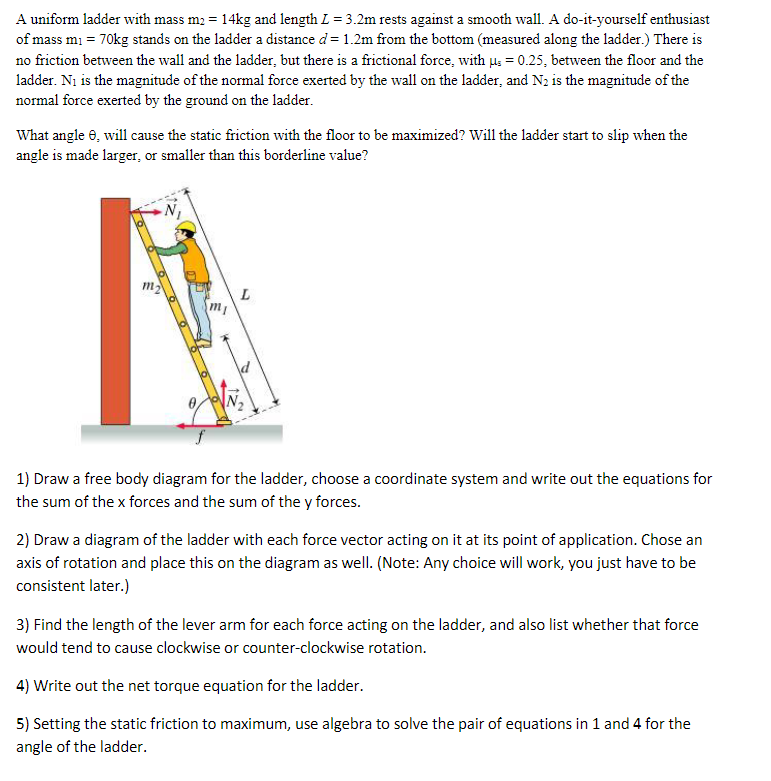A uniform ladder with mass m2 = 14kg and length L = 3.2m rests against a smooth wall. A do-it-yourself enthusiast of mass m₁ = 70kg stands on the ladder a distance d = 1.2m from the bottom (measured along the ladder.) There is no friction between the wall and the ladder, but there is a frictional force, with µ = 0.25, between the floor and the ladder. N₁ is the magnitude of the normal force exerted by the wall on the ladder, and N₂ is the magnitude of the normal force exerted by the ground on the ladder. What angle 6, will cause the static friction with the floor to be maximized? Will the ladder start to slip when the angle is made larger, or smaller than this borderline value?
A uniform ladder with mass m2 = 14kg and length L = 3.2m rests against a smooth wall. A do-it-yourself enthusiast of mass m₁ = 70kg stands on the ladder a distance d = 1.2m from the bottom (measured along the ladder.) There is no friction between the wall and the ladder, but there is a frictional force, with µ = 0.25, between the floor and the ladder. N₁ is the magnitude of the normal force exerted by the wall on the ladder, and N₂ is the magnitude of the normal force exerted by the ground on the ladder. What angle 6, will cause the static friction with the floor to be maximized? Will the ladder start to slip when the angle is made larger, or smaller than this borderline value?
Elements Of Electromagnetics
7th Edition
ISBN:9780190698614
Author:Sadiku, Matthew N. O.
Publisher:Sadiku, Matthew N. O.
ChapterMA: Math Assessment
Section: Chapter Questions
Problem 1.1MA
Related questions
Question
100%

Transcribed Image Text:A uniform ladder with mass m₂ = 14kg and length L = 3.2m rests against a smooth wall. A do-it-yourself enthusiast
of mass m₁ = 70kg stands on the ladder a distance d = 1.2m from the bottom (measured along the ladder.) There is
no friction between the wall and the ladder, but there is a frictional force, with μ = 0.25, between the floor and the
ladder. N₁ is the magnitude of the normal force exerted by the wall on the ladder, and N₂ is the magnitude of the
normal force exerted by the ground on the ladder.
What angle 8, will cause the static friction with the floor to be maximized? Will the ladder start to slip when the
angle is made larger, or smaller than this borderline value?
m₂
20
f
L
mi
1) Draw a free body diagram for the ladder, choose a coordinate system and write out the equations for
the sum of the x forces and the sum of the y forces.
2) Draw a diagram of the ladder with each force vector acting on it at its point of application. Chose an
axis of rotation and place this on the diagram as well. (Note: Any choice will work, you just have to be
consistent later.)
3) Find the length of the lever arm for each force acting on the ladder, and also list whether that force
would tend to cause clockwise or counter-clockwise rotation.
4) Write out the net torque equation for the ladder.
5) Setting the static friction to maximum, use algebra to solve the pair of equations in 1 and 4 for the
angle of the ladder.
Expert Solution
This question has been solved!
Explore an expertly crafted, step-by-step solution for a thorough understanding of key concepts.
This is a popular solution!
Trending now
This is a popular solution!
Step by step
Solved in 6 steps with 3 images

Follow-up Questions
Read through expert solutions to related follow-up questions below.
Follow-up Question
How did you simplify the torque equation at the beginning of step 5?
Solution
Knowledge Booster
Learn more about
Need a deep-dive on the concept behind this application? Look no further. Learn more about this topic, mechanical-engineering and related others by exploring similar questions and additional content below.Recommended textbooks for you

Elements Of Electromagnetics
Mechanical Engineering
ISBN:
9780190698614
Author:
Sadiku, Matthew N. O.
Publisher:
Oxford University Press

Mechanics of Materials (10th Edition)
Mechanical Engineering
ISBN:
9780134319650
Author:
Russell C. Hibbeler
Publisher:
PEARSON

Thermodynamics: An Engineering Approach
Mechanical Engineering
ISBN:
9781259822674
Author:
Yunus A. Cengel Dr., Michael A. Boles
Publisher:
McGraw-Hill Education

Elements Of Electromagnetics
Mechanical Engineering
ISBN:
9780190698614
Author:
Sadiku, Matthew N. O.
Publisher:
Oxford University Press

Mechanics of Materials (10th Edition)
Mechanical Engineering
ISBN:
9780134319650
Author:
Russell C. Hibbeler
Publisher:
PEARSON

Thermodynamics: An Engineering Approach
Mechanical Engineering
ISBN:
9781259822674
Author:
Yunus A. Cengel Dr., Michael A. Boles
Publisher:
McGraw-Hill Education

Control Systems Engineering
Mechanical Engineering
ISBN:
9781118170519
Author:
Norman S. Nise
Publisher:
WILEY

Mechanics of Materials (MindTap Course List)
Mechanical Engineering
ISBN:
9781337093347
Author:
Barry J. Goodno, James M. Gere
Publisher:
Cengage Learning

Engineering Mechanics: Statics
Mechanical Engineering
ISBN:
9781118807330
Author:
James L. Meriam, L. G. Kraige, J. N. Bolton
Publisher:
WILEY